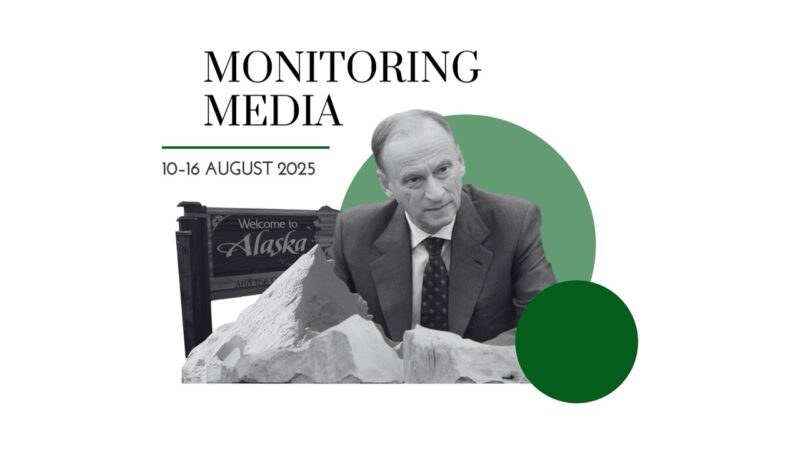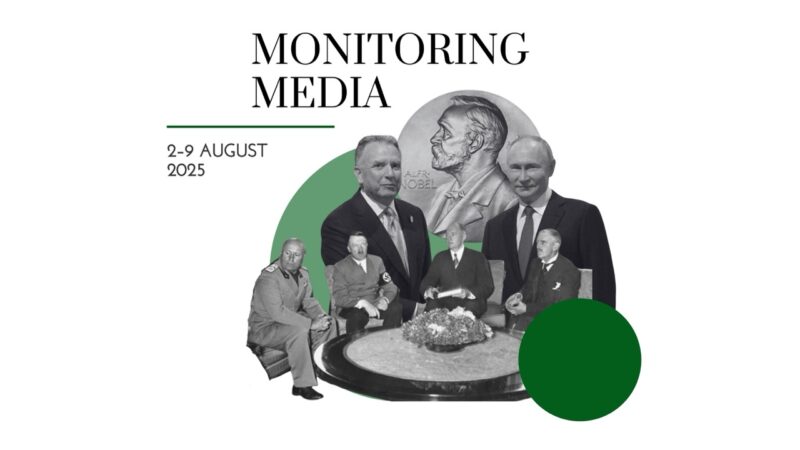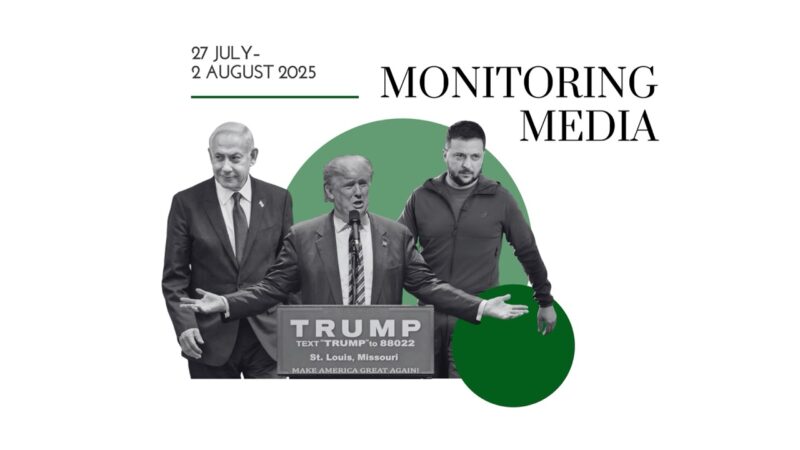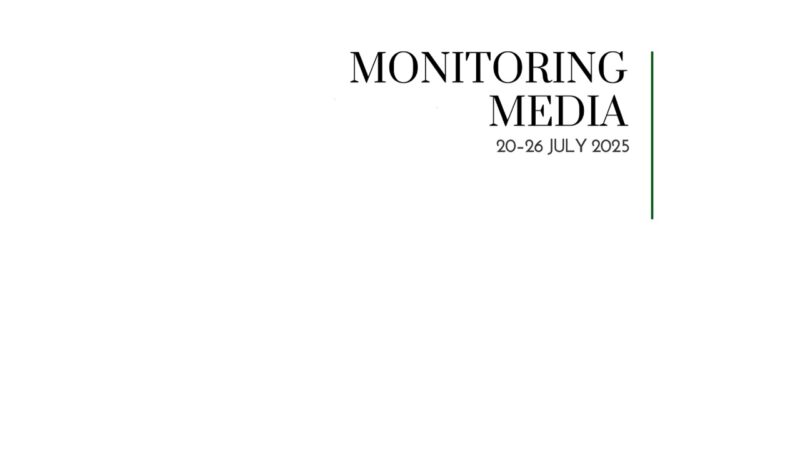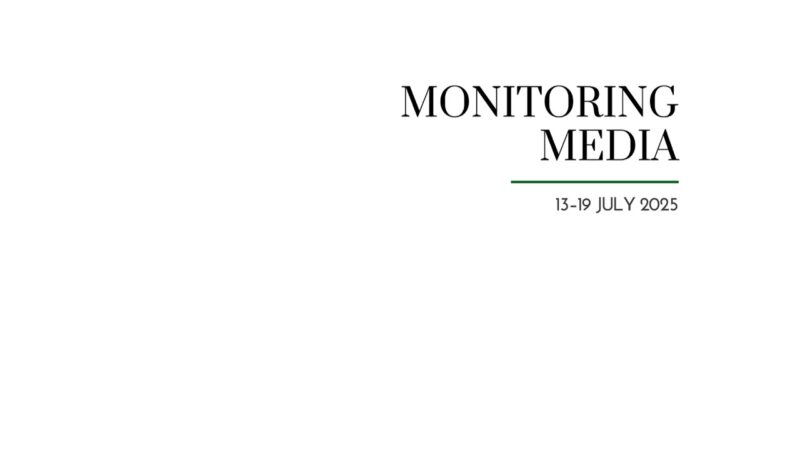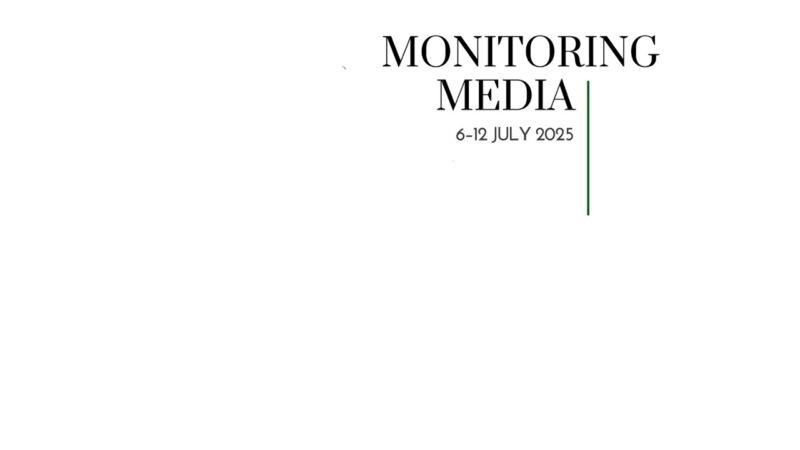The war is weakening Russia’s influence

CIUS weekly report on North American media coverage of Ukrainian affairs, 30 June–6 July 2024
Six publications (The Economist, Foreign Affairs, The Atlantic, The Wall Street Journal, Foreign Policy, and Politico) were selected to prepare this report on how Ukraine has been portrayed in the North American press during the past week. The sample was compiled based on their impact on public opinion as well as on their professional reputation, popularity among the readership, and topical relevance. These publications represent centrist viewpoints on the political spectrum.
This MMS report covers only the most-read and relevant articles about Ukraine, as ranked by the respective North American publications themselves in the past week. Its scope covers promoted articles on home pages and articles from special sections on Ukraine, with the hashtag #Ukraine, from the paper editions of the publications, and about Ukraine from opinion columns and editorials.
Featured topics
- The world and Ukraine: Ukraine has a month to avoid default; what NATO means to the world; Russia’s war against Ukraine is the military conflict of the future.
- Russia at war: the war is weakening Russia’s influence in the post-Soviet space.
MMS summaries
Ukraine has a month to avoid default. The editorial board of the Economist argues that Ukraine has one month to avoid default. Russia’s war against Ukraine has put its economy in a difficult position. Numerous Russian attacks on infrastructure have only worsened the situation. Despite the fact that the US Congress has approved a $60-billion support package for Kyiv, and the G7 plans to “use Russian central-bank assets frozen in Western financial institutions to lend another $50,” this is not enough. Ukraine is facing a cash crunch. Over the past two years, Ukraine’s creditors have agreed to suspend debt service payments. However, for private foreign bondholders the moratorium expires on 1 August 2024. In the absence of agreements with creditors, Kyiv has two options: (1) “to negotiate an extension on its debt-service freeze, as it has already with official creditors, who will forgo payments until 2027”; or (2) to default. According to the editorial board, there is no difference between the scenarios: “Either way, Ukrainian payments will not resume.” According to the Economist, “Much of Ukraine’s recovery—including the construction of basic infrastructure and civic buildings, as well as training people to rebuild the country—will never turn a profit, and thus it will need to be shouldered by the country’s allies. The current impasse raises a worrying prospect: that distrust between them and private investors will slow down progress. Mr. Marchenko (Ukraine’s finance minister) was right to remind Ukraine’s commercial creditors that a country’s army is only as strong as the economy behind it. He could also have reminded Ukraine’s allies that an economy is only as strong as the army keeping it in existence.”
What NATO means to the world. Jens Stoltenberg (Foreign Affairs) emphasizes that the meeting of 32 NATO leaders in Washington is not only a tribute to the 75th anniversary of the Alliance but also an opportunity “to make decisions that matter for the future of one billion people across Europe and North America.” As a result of Russia’s war against Ukraine, their security is at risk: “When Russian President Vladimir Putin sent tanks into Ukraine in February 2022, he began the bloodiest conflict in Europe since World War II, shattering peace on the continent and creating turmoil on the global stage.” However, NATO’s main goal is not to wage war but to prevent it: “The alliance does not seek confrontation with Russia. But we have supported and will continue to do all we can to support Ukraine’s fundamental right to self-defense, as enshrined in the UN Charter.” Meanwhile, Moscow is coordinating its actions with other autocracies around the world in order to undermine the power of NATO states: “This shows that in today’s world, security is not a regional matter but a global one. Europe’s security affects Asia, and Asia’s security affects Europe.” According to Stoltenberg, “These are big challenges that call for bold decisions, and that is what alliance leaders will address at the NATO summit. Starting at home, we will strengthen our own defenses to keep our people safe. We will also bolster our support for Ukraine and work hand in hand with our partners in the Indo-Pacific on our shared security concerns. The result will be an even stronger NATO—ready to respond to challenges today and for the long term.”
In Ukraine, we are witnessing the war of the future. Raj Shah and Christopher Kirchhoff (Atlantic) emphasize that Russia’s war against Ukraine demonstrates the decisive influence that technologies have on modern military conflicts. Commercial technologies were the first to detect Russia’s full-scale invasion of Ukraine, and later they played a crucial role in Kyiv’s defence: “Ukrainian forces, outmanned and outgunned, relied on an ingenious collection of start-ups to repel Russia in the early stages of the conflict. In many cases, Silicon Valley strengthened Ukraine’s military more quickly—and at a far lower cost—than systems from established defense contractors.”
According to the authors, modern technologies have changed almost all areas of warfare and strengthened Ukraine’s defence capabilities: “When Russia jammed Ukrainians’ radios, they switched to Starlink internet terminals, running their command and control through encrypted smartphone apps such as Signal and WhatsApp. Skydio, the first private US drone maker to be valued at $1 billion, rushed autonomous quadcopters with high-resolution cameras to Ukrainian infantry units, which used them to scout Russian positions and guide artillery fire. BlueHalo delivered Titan systems to the front that knocked enemy drones out of the sky. Anduril deployed its Ghost drone, a near-silent autonomous helicopter that could be set up in minutes.” At the same time, Russia’s aggression against Ukraine has exposed the Pentagon’s gaps in commercial technology engagement—gaps that were filled by private Ukrainian campaigns. Ukrainian start-ups were creating technology at the level of Silicon Valley, but they were not like traditional early-stage companies: “They were built to kill Russians, not navigate supply-chain bottlenecks or market themselves to the military or international investors.” According to Shah and Kirchhoff, “To the extent that US military and civilian leadership had a strategy for the future of US forces, when Putin invaded Ukraine it was mostly built on existing budgets and old-school weapons. Russia’s deployment of commercial technology has rendered much of that spending obsolete.”
The war is weakening Russia’s influence. Sha Hua (Wall Street Journal) argues that Russia’s war against Ukraine is weakening Moscow’s influence in the post-Soviet space. Firstly, it is about Russia’s influence on the countries of Central Asia: “In Central Asia, as in the Arctic, Moscow’s reliance on Beijing to sustain its war machine forces it to acquiesce to the encroachments.” For many years, there had been a balance of spheres of influence between Russia and China in the region: “Russia is the main security provider, while China focuses on development and investment.” However, according to the author, everything changed after Russia’s full-scale invasion of Ukraine: “Instead of supporting Moscow, all five Central Asian states opted to stay neutral on the invasion.” China has taken advantage of this imbalance: “Trade between China and Central Asia rose to $89 billion last year. In Uzbekistan, the most populous and industrialized of the five post-Soviet Central Asian nations, China knocked Russia from the top trade partner spot in 2023, according to official statistics.” For both states, this region is extremely important: for Moscow it provides access to the South Asian markets, and for Beijing it presents an opportunity to unite the whole of Eurasia into one large infrastructure project—the Belt and Road Initiative. According to Hua, all the Central Asian countries are rapidly drifting towards China because “they all think China is the future.”
NATO leaders must draw the right lessons from recent decades. Daniel Treisman (Foreign Policy) reminds readers that US President Joe Biden has long supported Ukraine’s integration into NATO, a stance he maintained even when a majority of Ukrainians opposed it. Although Biden reiterated his commitment to Ukraine joining NATO in Vilnius last summer, in fear of nuclear escalation he has also emphasized that the United States will not engage in direct conflict with Russia in order to defend Kyiv. This cautious approach has led to delays in supplying advanced weapons to Ukraine, and to limitations on their use, a strategy criticized for hindering Ukraine’s defence. The core of Biden’s strategy is to prevent World War III, as he said in 2022, aligning with his administration’s efforts to avoid provoking Russia while still supporting Ukraine. The broader issue lies in NATO’s post-1989 enlargement, which saw the alliance grow by 16 countries while simultaneously reducing military spending and forces, leaving new members vulnerable, especially those bordering Russia. The author argues that NATO’s growth without adequate defence investments has created a perception of weakness that Putin aims to exploit. To strengthen deterrence, NATO must bolster its eastern borders and ensure robust conventional defence capacities for Ukraine. “To avoid vulnerability to Putin’s blackmail, we must prevent Russian troops from seizing land and then declaring it under their nuclear umbrella,” Treisman asserts, highlighting the urgent need for reinforced defences over mere promises of support.
Trump’s NATO strategy will likely involve a Ukraine peace deal, territorial concessions. Michael Hirsh (Politico) writes that former US president Donald Trump’s potential reelection could lead to significant changes in US policy toward NATO and the ongoing war in Ukraine. Trump has indicated that he would seek a swift resolution to the Russo-Ukrainian war, potentially involving negotiations with Russian leader Vladimir Putin over territorial concessions. This plan, which has not been previously reported in detail, includes foreclosing on NATO membership for Ukraine and Georgia, and negotiating the extent of Ukrainian territory that Moscow could retain. Trump’s national security advisors suggest that this approach would prioritize ending the war quickly, even if it means Ukraine ceding parts of its territory. Trump himself has criticized the promise of NATO membership to Ukraine, attributing it as a major reason for the war’s initiation. Kevin Roberts, president of the Heritage Foundation, speculates that Trump would push for a rapid peace deal that might involve substantial compromises from Ukraine. This strategy has raised concerns among Trump’s critics, who argue that pressuring Ukraine to surrender territory would only validate Putin’s aggressive actions and undermine international law. Despite these concerns, Trump’s advisors believe that redefining NATO’s role and pushing for European countries to take on more responsibility are essential, due to the US’s rising national debt and military recruitment challenges. Elbridge Colby, who led the development of Trump’s National Defence Strategy, emphasized the urgent need for Europe’s readiness: “They need to be producing combat-credible forces to deal with a Russian attack, like NOW.” Trump’s former national security adviser, John Bolton, has suggested that his goal may be not to strengthen NATO but rather to lay the groundwork for the US’s withdrawal. Nonetheless, Trump’s advisors maintain that his pressure on NATO has already led to increased defence spending among European allies. Trump’s approach to NATO and the ongoing war Russia’s war indicates a significant shift toward a more isolationist US foreign policy, with potentially profound implications for transatlantic security.
Ukraine Railways expansion aims to strengthen economic independence, European ties. Maxim Edwards and Kristina Berdynskykh (Foreign Policy) argue that Ukrzaliznytsia, Ukraine’s national railway company, has become a pivotal element in the nation’s war effort against Russia, demonstrating widely recognized resilience and adaptability. Since the full-scale invasion began, the railway has been instrumental in transporting troops, evacuating refugees, and maintaining crucial supply lines, particularly when sea routes became unsafe due to Russian naval threats. Beyond merely surviving, Ukrzaliznytsia has expanded its operations, restoring and constructing new freight and passenger lines with substantial international financial support, including a 200-million-euro loan from the European Bank for Reconstruction and Development. This expansion highlights Ukraine’s strategic shift from its historical orientation on Russia to a deeper integration with Europe. However, in this process Ukraine faces significant challenges due to its railway infrastructure’s legacy from Soviet times. The differing railway gauge between Ukraine and most of Europe adds complexity and delays to cross-border transit. Converting Ukraine’s extensive rail network to the European gauge is a costly and long-term endeavour. Despite the financial and logistical hurdles, Ukraine’s focus on modernizing its railways reflects its broader ambitions for economic recovery and strategic independence from Russia: “Because it’s about more than a gauge, [it’s] an economic path,” said Yevhen Lyashchenko, who heads Ukrzaliznytsia. The authors underscore that the more efficiently goods can move in and out of Ukraine, the more appealing the country will become for business, reducing its need for macroeconomic support from the EU. Lyashchenko adds that “in the case of war, the same gauge greatly improves the efficiency of weapons deliveries.” Although the upfront costs of integrating Ukraine’s railway network with Europe’s are substantial, Ukrainian policymakers view this investment as a crucial opportunity to strengthen the country’s long-term economic independence.
